

 |
Search the Site with

|
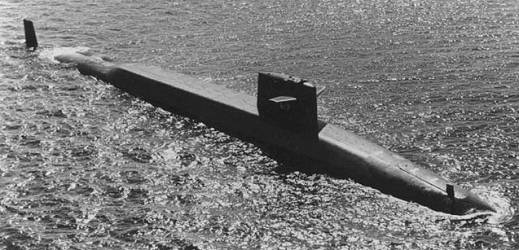 | 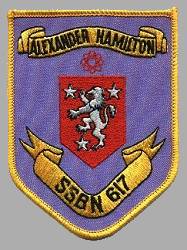 |
USS ALEXANDER HAMILTON was the second LAFAYETTE - class nuclear powered fleet ballistic missile submarine and the third ship in the Navy to bear the name. Decommissioned and stricken from the Navy list on February 23, 1993, the ALEXANDER HAMILTON was disposed of through the Nuclear Powered Ship and Submarine Recycling Program one year later at the Puget Sound Naval Shipyard, Bremerton, WA. Recycling was finished on February 28, 1994.
| General Characteristics: | Awarded: July 22, 1960 |
| Keel laid: June 26, 1961 | |
| Launched: August 18, 1962 | |
| Commissioned: June 27, 1963 | |
| Decommissioned: February 23, 1993 | |
| Builder: Electric Boat Division, General Dynamics Corp., Groton, CT. | |
| Propulsion system: one S5W nuclear reactor | |
| Propellers: one | |
| Length: 425 feet (129.6 meters) | |
| Beam: 33 feet (10 meters) | |
| Draft: 31.5 feet (9.6 meters) | |
| Displacement: Surfaced: approx. 7,250 tons; Submerged: approx. 8,250 tons | |
| Speed: Surfaced: 16 - 20 knots;Submerged: 22 - 25 knots | |
| Armament: 16 vertical tubes for Polaris or Poseidon missiles, four 21" torpedo tubes for | |
| Crew: 13 Officers and 130 Enlisted (two crews) |
Crew List:
This section contains the names of sailors who served aboard USS ALEXANDER HAMILTON. It is no official listing but contains the names of sailors who submitted their information.
Accidents aboard USS ALEXANDER HAMILTON:
| Date | Where | Events |
|---|---|---|
| March 7, 1979 | Sound of Sura, west of Scotland | USS ALEXANDER HAMILTON becomes tangled in the nets of a Scottish fishing trawler. The ALEXANDER HAMILTON tows the trawler backward for about 45 minutes until the nets are cut. No injuries or serious damage result. |
About the Ship's Name:
Alexander Hamilton - born at Nevis in the Leeward Islands in either 1755 or 1757 - emigrated to New York in 1772. There, he entered Kings College (now Columbia University) in 1773 but interrupted his studies to become involved in some of the events which led to the American Revolution by authoring several pamphlets. When the war did come, he was commissioned the captain of an artillery company. Hamilton participated in the Long Island campaign and the retreat through New Jersey before attracting General George Washington's attention and becoming his secretary and aide de camp in March 1777. He served in that capacity, in the rank of lieutenant colonel, until February of 1781 when, as a result of a quarrel with Washington he resigned his post. Washington, both magnaminous and pragmatic in regard to Hamilton's ability, allowed him to be appointed to head an infantry regiment which he led brilliantly during the Yorktown campaign.
When the war ended, Hamilton read law at Albany, N. Y., and was admitted to the bar. He served a single term in the Continental Congress before returning to private life and beginning the law practice in New York City. However, he remained active in his support for a strong federal government. Hamilton was appointed a delegate from New York to the Constitutional Convention in 1787 though his work at the convention was of little importance. Far more significant was his almost lone struggle in New York to secure ratification of the Constitution. He waged a fierce newspaper war in favor of its adoption and concocted the idea for the Federalist Papers, most of which he wrote alone or in cooperation with James Madison. Though New York at the time was extremely particularist, the sheer force of Hamilton's arguments carried the day and secured the state's adherence to the Constitution at the Poughkeepsie meeting in July 1788. In that year, the young lawyer returned to the Continental Congrss and figured prominently in the formation of the new government.
Hamilton was appointed Secretary of the Treasury in September 1789 and immediately set out to establish the nation's credit on a sound basis. On 14 January 1790, he submitted his plan to the House of Representatives; and the document remains one of his lasting contributions to the foundation of the federal government. He argued that the central government should be responsible for all debts contracted during the Revolution-foreign and domestic-including those debts contracted by the individual states. Though the measure encountered fierce opposition, he finally secured its adoption on 4 August 1791.
Hamilton's tenure of of fice as Secretary of the Treasury lasted until 1795. During that period, the verbal battles with Jefferson - Hamilton's natural antagonist - rose to fever pitch. Both conducted propaganda campaigns in the press, and Jefferson's attacks finally culminated in the introduction of nine resolutions of censure against Hamilton into Congress. The defeat of those resolutions early in 1793 proved a vindication of Hamilton and his policies. Hamilton exercised a great deal of influence over John Jay's negotiations with Great Britain which secured a treaty favorable to the new nation's domestic economy. This meddling in foreign affairs no doubt influenced Jefferson's resignation as Secretary of State at the end of 1793. Jefferson intensified his anti-Hamilton campaign after that because he felt Hamilton to be too speculative at home and pro-British abroad. Domestically however, Hamilton was secure. He proved that in 1794 when he played a leading role in the suppression of the Whiskey Rebellion. He regarded the Federal action at this time as an outstanding opportunity for the central government to exhibit its strength.
Personal financial difficulties forced Hamilton to resign from the cabinet in January 1795 and he never returned to public office. He did, however, continue to support the Federalist cause and remained a close advisor to Washington. Personal antipathy to John Adams minimized Hamilton's influence during that presidency, though he tried to exercise it upon Adams' cabinet nonetheless. His last two great acts came in 1800 and 1804, respectively, and both had Aaron Burr as their target. During the election of 1800, when Jefferson and Burr tied for the Presidency and the election went to the House of Representatives Hamilton broke with the other Federalists and used his influence to secure Jefferson's election. In 1804, he successfully maneuvered to assure Burr's defeat in his bid to become governor of New York. Burr, it was believed, would probably have joined the secessionist Northern Confederacy had he been elected. As a result, Burr challenged Hamilton to a duel on the pretext that the latter had expressed a "despicable opinion of him." The affair took place at Weehawken, N.J. on 11 July 1804. Burr wounded Hamilton mortally, and the latter died the following day. Hamilton was buried at Trinity Church in New York.
History of USS ALEXANDER HAMILTON:
USS ALEXANDER HAMILTON was laid down on 26 June 1961 at Groton, Conn., by the Electric Boat Division, General Dynamics Corp.; launched on 18 August 1962; sponsored by Mrs. Valentine Hollingsworth, Jr., the great-great-great granddaughter of Alexander Hamilton, and commissioned on 27 June 1963, Comdr. Norman B. Bessac (Blue Crew) and Comdr. Benjamin F. Sherman, Jr., (Gold Crew) in command.
Between 28 June and 18 October, ALEXANDER HAMILTON carried out two shakedown cruises-one for her Blue crew and a second for her Gold. Following those operations, she conducted post-shakedown availability. After trials early in 1964, she departed the east coast on 16 March to deploy to Rota, Spain, her base of operations. She conducted deterrent patrols out of that port for the remainder of the year as a unit of Submarine Squadron (SubRon) 16. In January 1965, the fleet ballistic missile submarine transferred to SubRon 14 and based at Holy Loch Scotland. Her cycle of patrols from there lasted until 2 June 1967 at which time she returned to the United States at Charleston S. C. Later that month, she moved north to New London, Conn. and thence into the Electric Boat yard on the 18th to begin her first overhaul and nuclear refueling.
ALEXANDER HAMILTON completed the overhaul on 28 June 1968 and conducted post-overhaul trials, inspections, and shakedown training until early October. In November, she was deployed to Rota and conducted a deterrent patrol en route to her new base where she arrived on 30 December. For the next four years, the submarine operated from that Spanish port-again as a unit of SubRon 16. At the conclusion of her 31st deterrent patrol she returned to Charleston in November 1972 and, in January 1973 began her second refueling overhaul-combined with a conversion to carry Poseidon missiles-at the yard of the Newport News Shipbuilding & Dry Uock Co. The work on those two modifications lasted for over two years. The submarine carried out shakedown in April of 1975 and devoted the remainder of the year to training and various post overhaul trials. She conducted deterrent patrols 32 and 33 in the early part of 1976. ALEXANDER HAMILTON concluded the latter patrol at Holy Loch, Scotland, in May 1976 and conducted her next three patrols from that base. While on patrol 36, the fleet ballistic missile submarine visited Port Canaveral, Fla., and New London, Conn., before concluding that patrol at Charleston, S.C., in March 1977. During March and April, she completed refit and conducted refresher training. In July, she departed Charleston for another deterrent patrol which ended with her arrival at Holy Loch in September.
From that Scottish base, the fleet ballistic missile submarine conducted deterrent patrols 39 and 40. She departed Holy Loch in May 1978 for patrol 41 and concluded it at Charleston in July. The warship remained there until August when she got underway for New London. She arrived at New London early in September and, after exchanging crews, embarked upon deterrent patrol 42 later that month. She ended that patrol at Holy Loch in October. Over the next year, she made four patrols from the base in Scotland. On 31 October 1979, ALEXANDER HAMILTON departed Holy Loch on her 46th deterrent patrol, ending it at Charleston on 7 December. Early in January 1980, the ballistic missile submarine departed Charleston on deterrent patrol 47. She concluded that patrol at Holy Loch on 17 March 1980 and; for the remainder of the year, operated from that base.
ALEXANDER HAMILTON's deterrent patrols out of Holy Loch continued until 1986. At that time, she was to have been decommissioned in order to remove her from the fleet as a gesture of goodwill in accordance with the terms of the unratified SALT II strategic arms limitation treaty. Upon her arrival in Groton early in 1986, the ballistic missile submarine began preparations for deactivation. The grounding of USS NATHANAEL GREENE (SSBN 636), however, forced the Navy to change its plans. What had been a deactivation overhaul quickly became a four-week maintenance availability to get ALEXANDER HAMILTON ready for active service. In April, the warship sailed to Charleston, S.C. for further work conducted in the floating drydock ALAMOGORDO (ARDM 4). While at Charleston, she also served at sea occasionally as a training platform. In mid-June, the warship returned to Groton. During the summer of 1986, ALEXANDER HAMILTON participated in training cruises for Naval Academy and NROTC midshipmen.
In August, she learned that her refueling overhaul would be conducted by the Puget Sound Naval Shipyard. The nuclear-powered ballistic missile submarine departed Groton on 1 October to begin the long voyage to Bremerton, Wash. Steaming by way of the Panama Canal, she arrived at her destination late in November. Alexander Hamilton formally began her refueling overhaul on 30 November 1986.
After the overhaul the ALEXANDER HAMILTON returned to the east coast and operated out of Groton, CT, until decommissioned on February 23, 1993. Stricken from the Navy list the same day, the ALEXANDER HAMILTON was disposed of through the Nuclear Powered Ship and Submarine Recycling Program one year later at the Puget Sound Naval Shipyard, Bremerton, WA. Recycling on finished on February 28, 1994.
USS ALEXANDER HAMILTON Image Gallery:
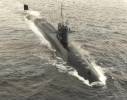 | 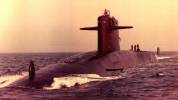 | 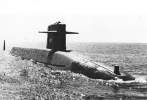 |
 Back to Ballistic Submarines list.
Back to Ballistic Submarines list.  Back to ships list.
Back to ships list.  Back to selection page.
Back to selection page.  Back to 1st page.
Back to 1st page.